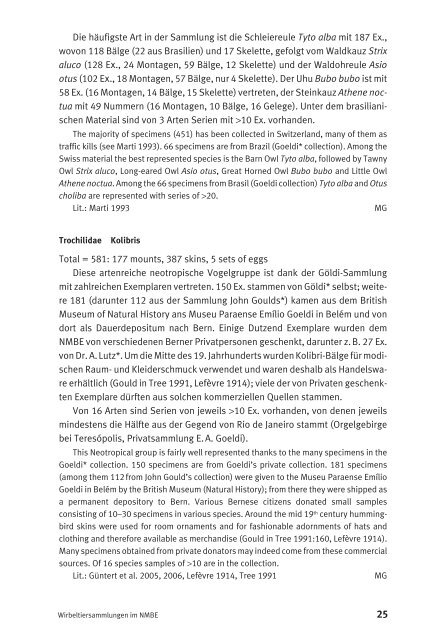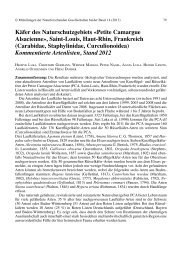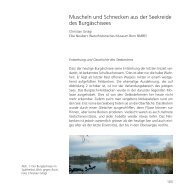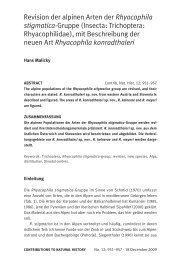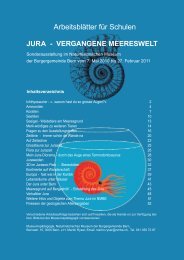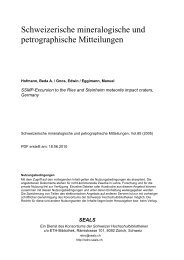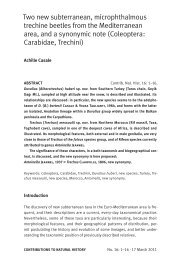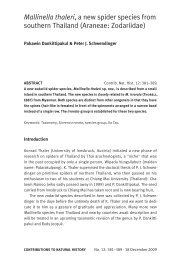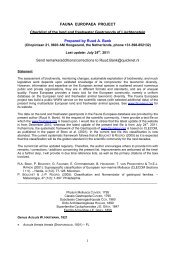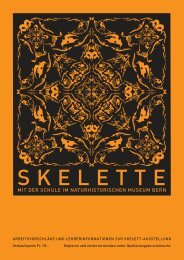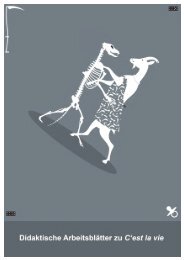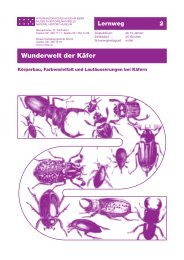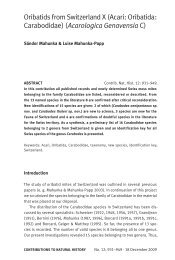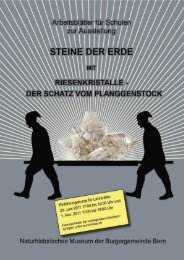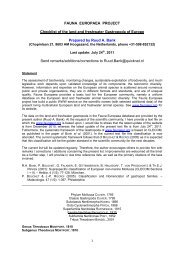Wirbeltiersammlungen im Natur - Naturhistorisches Museum Bern
Wirbeltiersammlungen im Natur - Naturhistorisches Museum Bern
Wirbeltiersammlungen im Natur - Naturhistorisches Museum Bern
Sie wollen auch ein ePaper? Erhöhen Sie die Reichweite Ihrer Titel.
YUMPU macht aus Druck-PDFs automatisch weboptimierte ePaper, die Google liebt.
Die häufigste Art in der Sammlung ist die Schleiereule Tyto alba mit 187 Ex.,<br />
wovon 118 Bälge (22 aus Brasilien) und 17 Skelette, gefolgt vom Waldkauz Strix<br />
aluco (128 Ex., 24 Montagen, 59 Bälge, 12 Skelette) und der Waldohreule Asio<br />
otus (102 Ex., 18 Montagen, 57 Bälge, nur 4 Skelette).Der Uhu Bubo bubo ist mit<br />
58 Ex.(16 Montagen, 14 Bälge, 15 Skelette) vertreten, der Steinkauz Athene noctua<br />
mit 49 Nummern (16 Montagen, 10 Bälge, 16 Gelege).Unter dem brasilianischen<br />
Material sind von 3 Arten Serien mit > 10 Ex.vorhanden.<br />
The majority of spec<strong>im</strong>ens (451) has been collected in Switzerland, many of them as<br />
traffic kills (see Marti 1993). 66 spec<strong>im</strong>ens are from Brazil (Goeldi* collection).Among the<br />
Swiss material the best represented species is the Barn Owl Tyto alba, followed by Tawny<br />
Owl Strix aluco, Long-eared Owl Asio otus, Great Horned Owl Bubo bubo and Little Owl<br />
Athene noctua.Among the 66 spec<strong>im</strong>ens from Brasil (Goeldi collection) Tyto alba and Otus<br />
choliba are represented with series of > 20.<br />
Lit.: Marti 1993 MG<br />
Trochilidae Kolibris<br />
Total = 581: 177 mounts, 387 skins, 5 sets of eggs<br />
Diese artenreiche neotropische Vogelgruppe ist dank der Göldi-Sammlung<br />
mit zahlreichen Exemplaren vertreten. 150 Ex.stammen von Göldi* selbst; weitere<br />
181 (darunter 112 aus der Sammlung John Goulds*) kamen aus dem British<br />
<strong>Museum</strong> of <strong>Natur</strong>al History ans Museu Paraense Emílio Goeldi in Belém und von<br />
dort als Dauerdepositum nach <strong>Bern</strong>.Einige Dutzend Exemplare wurden dem<br />
NMBE von verschiedenen <strong>Bern</strong>er Privatpersonen geschenkt, darunter z.B.27 Ex.<br />
von Dr.A.Lutz*.Um die Mitte des 19.Jahrhunderts wurden Kolibri-Bälge für modischen<br />
Raum- und Kleiderschmuck verwendet und waren deshalb als Handelsware<br />
erhältlich (Gould in Tree 1991, Lefèvre 1914); viele der von Privaten geschenkten<br />
Exemplare dürften aus solchen kommerziellen Quellen stammen.<br />
Von 16 Arten sind Serien von jeweils > 10 Ex.vorhanden, von denen jeweils<br />
mindestens die Hälfte aus der Gegend von Rio de Janeiro stammt (Orgelgebirge<br />
bei Teresópolis, Privatsammlung E.A.Goeldi).<br />
This Neotropical group is fairly well represented thanks to the many spec<strong>im</strong>ens in the<br />
Goeldi* collection. 150 spec<strong>im</strong>ens are from Goeldi’s private collection. 181 spec<strong>im</strong>ens<br />
(among them 112 from John Gould’s collection) were given to the Museu Paraense Emílio<br />
Goeldi in Belém by the British <strong>Museum</strong> (<strong>Natur</strong>al History); from there they were shipped as<br />
a permanent depository to <strong>Bern</strong>.Various <strong>Bern</strong>ese citizens donated small samples<br />
consisting of 10–30 spec<strong>im</strong>ens in various species.Around the mid 19th century hummingbird<br />
skins were used for room ornaments and for fashionable adornments of hats and<br />
clothing and therefore available as merchandise (Gould in Tree 1991:160, Lefèvre 1914).<br />
Many spec<strong>im</strong>ens obtained from private donators may indeed come from these commercial<br />
sources.Of 16 species samples of > 10 are in the collection.<br />
Lit.: Güntert et al. 2005, 2006, Lefèvre 1914, Tree 1991 MG<br />
<strong>Wirbeltiersammlungen</strong> <strong>im</strong> NMBE<br />
25


